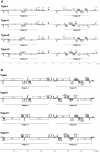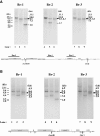Novel type of linear mitochondrial genomes with dual flip-flop inversion system in apicomplexan parasites, Babesia microti and Babesia rodhaini
- PMID: 23151128
- PMCID: PMC3546061
- DOI: 10.1186/1471-2164-13-622
Novel type of linear mitochondrial genomes with dual flip-flop inversion system in apicomplexan parasites, Babesia microti and Babesia rodhaini
Abstract
Background: Mitochondrial (mt) genomes vary considerably in size, structure and gene content. The mt genomes of the phylum Apicomplexa, which includes important human pathogens such as the malaria parasite Plasmodium, also show marked diversity of structure. Plasmodium has a concatenated linear mt genome of the smallest size (6-kb); Babesia and Theileria have a linear monomeric mt genome (6.5-kb to 8.2-kb) with terminal inverted repeats; Eimeria, which is distantly related to Plasmodium and Babesia/Theileria, possesses a mt genome (6.2-kb) with a concatemeric form similar to that of Plasmodium; Cryptosporidium, the earliest branching lineage within the phylum Apicomplexa, has no mt genome. We are interested in the evolutionary origin of linear mt genomes of Babesia/Theileria, and have investigated mt genome structures in members of archaeopiroplasmid, a lineage branched off earlier from Babesia/Theileria.
Results: The complete mt genomes of archaeopiroplasmid parasites, Babesia microti and Babesia rodhaini, were sequenced. The mt genomes of B. microti (11.1-kb) and B. rodhaini (6.9-kb) possess two pairs of unique inverted repeats, IR-A and IR-B. Flip-flop inversions between two IR-As and between two IR-Bs appear to generate four distinct genome structures that are present at an equi-molar ratio. An individual parasite contained multiple mt genome structures, with 20 copies and 2 - 3 copies per haploid nuclear genome in B. microti and B. rodhaini, respectively.
Conclusion: We found a novel linear monomeric mt genome structure of B. microti and B. rhodhaini equipped with dual flip-flop inversion system, by which four distinct genome structures are readily generated. To our knowledge, this study is the first to report the presence of two pairs of distinct IR sequences within a monomeric linear mt genome. The present finding provides insight into further understanding of evolution of mt genome structure.
Figures




Similar articles
-
Divergence of the mitochondrial genome structure in the apicomplexan parasites, Babesia and Theileria.Mol Biol Evol. 2010 May;27(5):1107-16. doi: 10.1093/molbev/msp320. Epub 2009 Dec 24. Mol Biol Evol. 2010. PMID: 20034997
-
Babesia gibsoni endemic to Wuhan, China: mitochondrial genome sequencing, annotation, and comparison with apicomplexan parasites.Parasitol Res. 2019 Jan;118(1):235-243. doi: 10.1007/s00436-018-6158-2. Epub 2018 Nov 24. Parasitol Res. 2019. PMID: 30474737
-
Mitochondrial genome of Babesia orientalis, apicomplexan parasite of water buffalo (Bubalus babalis, Linnaeus, 1758) endemic in China.Parasit Vectors. 2014 Feb 28;7:82. doi: 10.1186/1756-3305-7-82. Parasit Vectors. 2014. PMID: 24580772 Free PMC article.
-
Comparative Bioinformatics Analysis of Transcription Factor Genes Indicates Conservation of Key Regulatory Domains among Babesia bovis, Babesia microti, and Theileria equi.PLoS Negl Trop Dis. 2016 Nov 10;10(11):e0004983. doi: 10.1371/journal.pntd.0004983. eCollection 2016 Nov. PLoS Negl Trop Dis. 2016. PMID: 27832060 Free PMC article. Review.
-
Phylogeny and evolution of apicoplasts and apicomplexan parasites.Parasitol Int. 2015 Jun;64(3):254-9. doi: 10.1016/j.parint.2014.10.005. Epub 2014 Oct 14. Parasitol Int. 2015. PMID: 25451217 Review.
Cited by
-
Transfusion-transmitted Babesia spp.: a changing landscape of epidemiology, regulation, and risk mitigation.J Clin Microbiol. 2023 Oct 24;61(10):e0126822. doi: 10.1128/jcm.01268-22. Epub 2023 Sep 26. J Clin Microbiol. 2023. PMID: 37750699 Free PMC article. Review.
-
A novel fragmented mitochondrial genome in the protist pathogen Toxoplasma gondii and related tissue coccidia.Genome Res. 2021 May;31(5):852-865. doi: 10.1101/gr.266403.120. Epub 2021 Apr 27. Genome Res. 2021. PMID: 33906963 Free PMC article.
-
The Elusive Mitochondrial Genomes of Apicomplexa: Where Are We Now?Front Microbiol. 2021 Oct 15;12:751775. doi: 10.3389/fmicb.2021.751775. eCollection 2021. Front Microbiol. 2021. PMID: 34721355 Free PMC article. Review.
-
Babesia microti: Pathogen Genomics, Genetic Variability, Immunodominant Antigens, and Pathogenesis.Front Microbiol. 2021 Sep 3;12:697669. doi: 10.3389/fmicb.2021.697669. eCollection 2021. Front Microbiol. 2021. PMID: 34539601 Free PMC article. Review.
-
The linear mitochondrial genome of the quarantine chytrid Synchytrium endobioticum; insights into the evolution and recent history of an obligate biotrophic plant pathogen.BMC Evol Biol. 2018 Sep 10;18(1):136. doi: 10.1186/s12862-018-1246-6. BMC Evol Biol. 2018. PMID: 30200892 Free PMC article.
References
Publication types
MeSH terms
LinkOut - more resources
Full Text Sources
Research Materials

